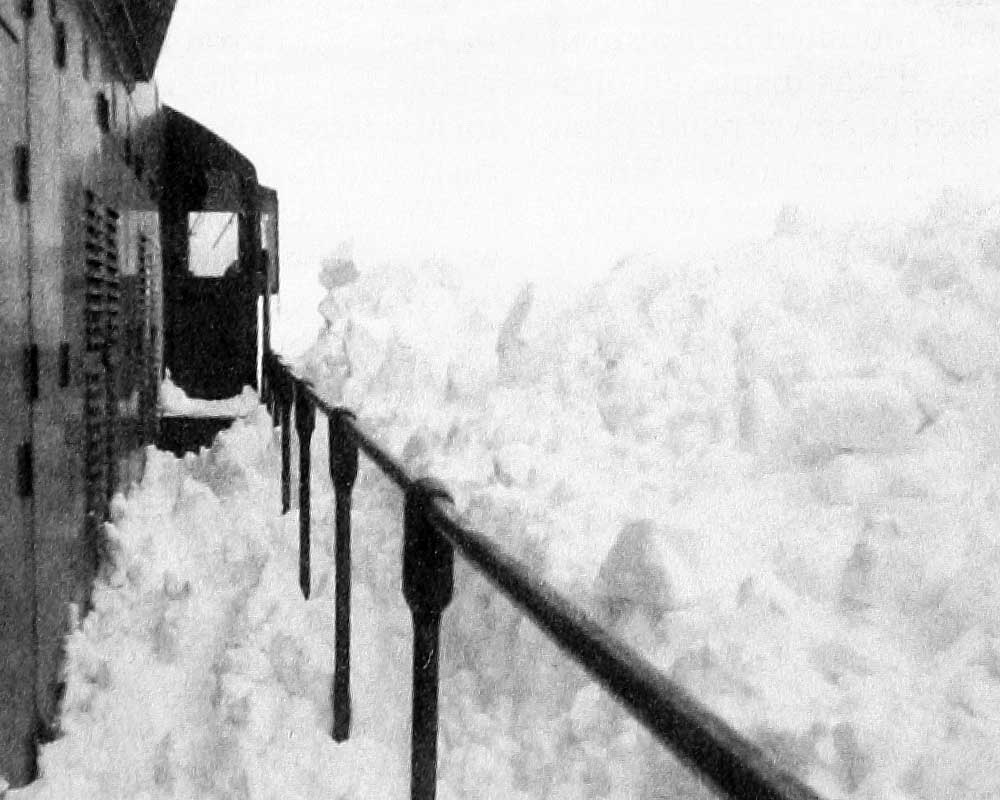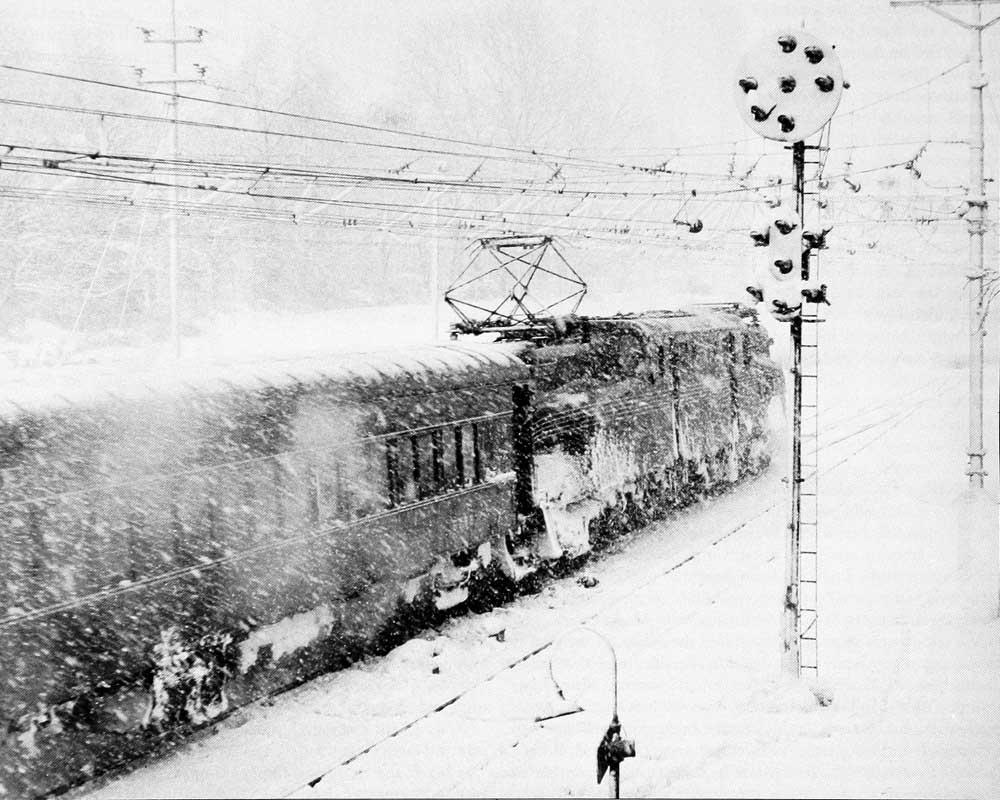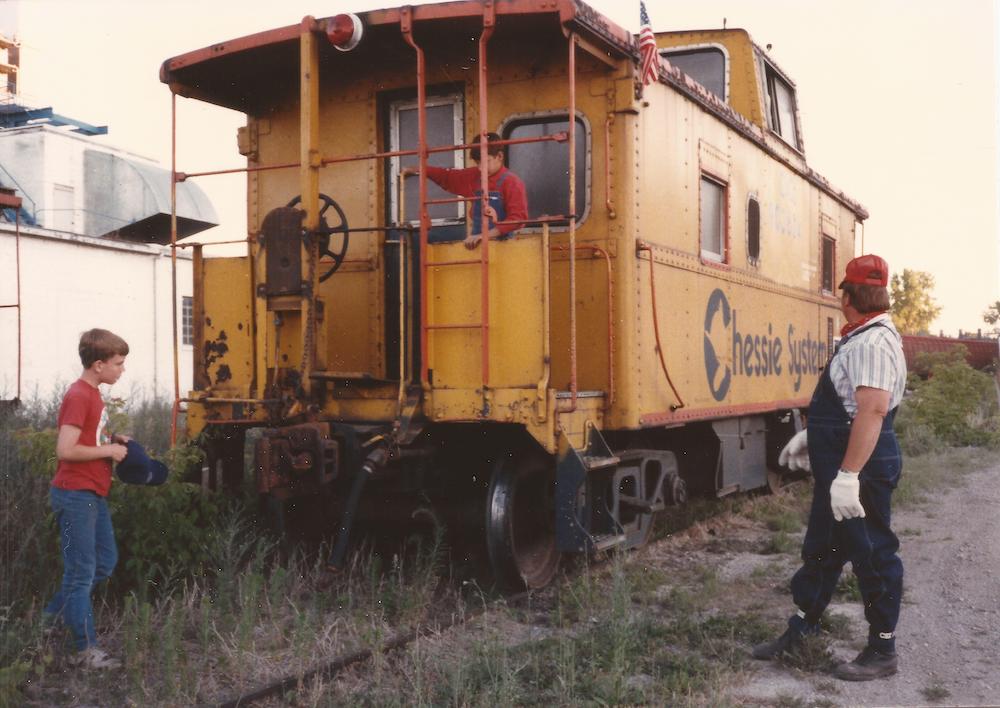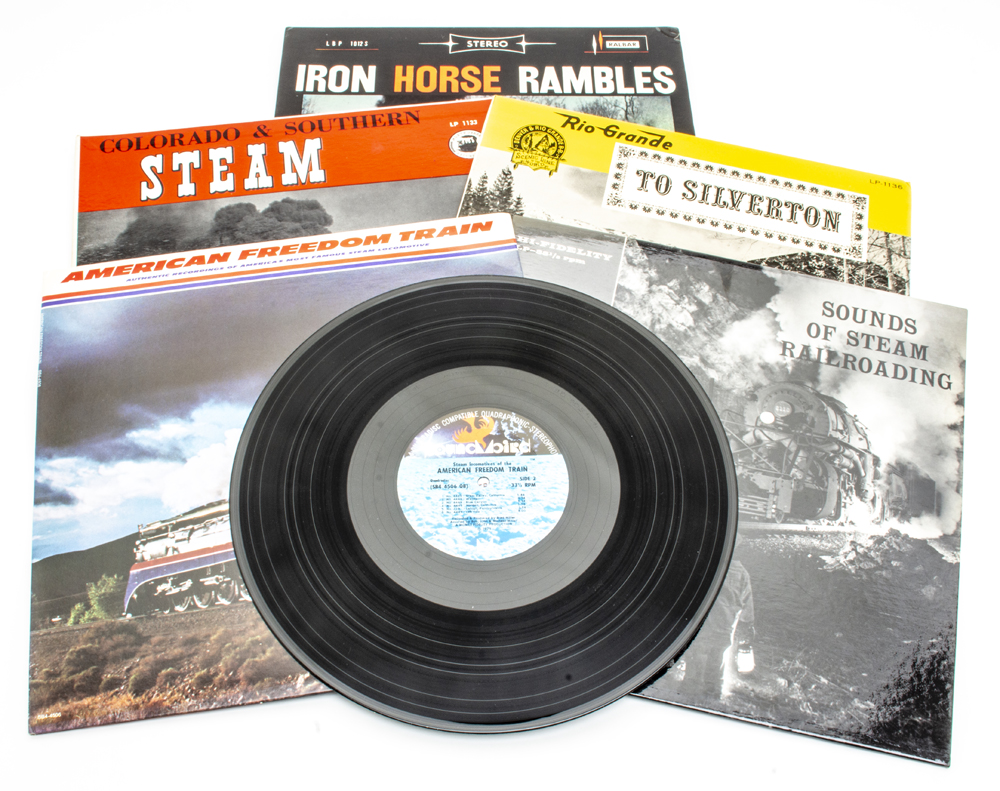I was working as a relief railroad tower operator on the Lehigh Valley in the late steam era. It was a beautiful late-summer evening when I left an Athens, Pa., diner and began walking along North Main Street. It was quiet as there was little traffic on this main artery that connected the Wilkes-Barre area, Sayre, and the New York-Pennsylvania border.
Most of the 4,400 residents of this northern Pennsylvania community were no doubt preparing for a good night’s rest. But the quiet was interrupted by the deep-throated whistle of an approaching Lehigh Valley locomotive. Up ahead, I could see crossing gates lowering and soon a large 4-8-4 locomotive trundled across Main Street trailing a seemingly endless line of freight cars and distinctive LV caboose.
Once the train cleared the crossing and the gates were up, I crossed the tracks and climbed the stairs to Athens Tower. It was about 9:35 p.m., June 29, 1950, when I was greeted and briefed by the second-trick towerman-telegrapher. He had just reported the early arrival of westbound train JM-1, a low-priority Jersey City to Manchester freight.
This would be my last night doing vacation relief work for the third-trick towerman-telegrapher. As in previous evenings and with no trains expected for the next two hours, I began reading the day’s train register while listening to the dispatchers’ lines. Athens daily freight operations usually consisted of six westbound symbol (scheduled) and up two westbound extra trains, four symbol and two to four extra eastbound trains, plus two local freights each way. The symbol trains generally operated close to their published times.
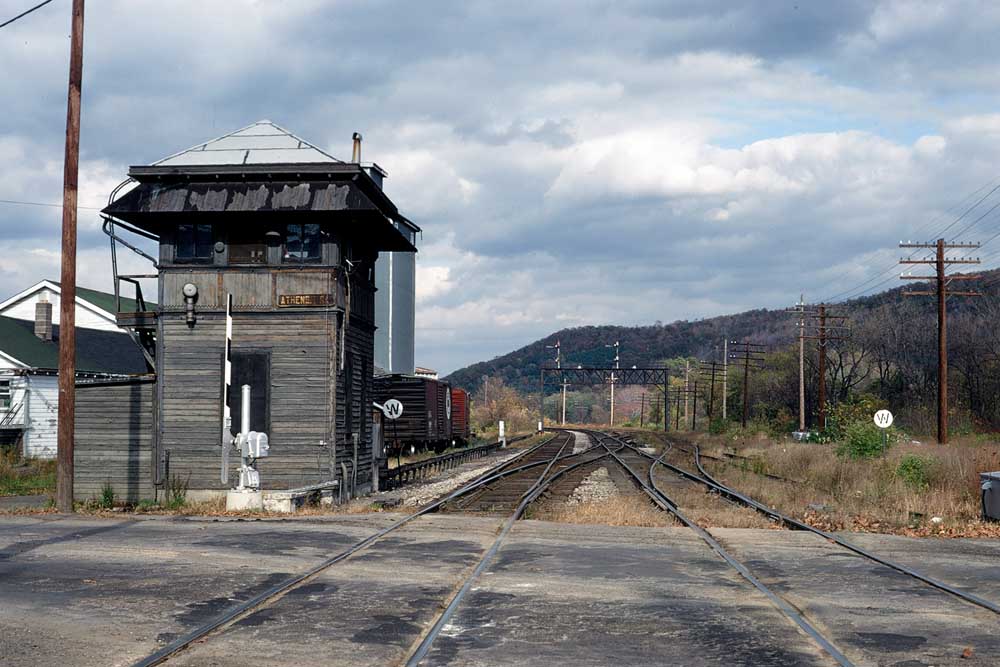
Traffic builds for Athens
My particular interest was the progress of trains headed for Athens. Lehighton Tower reported the on-time departure of No. 7, the Maple Leaf, at 10:07 p.m. Ithaca reported No. 4, the Star, a Buffalo-New York City train, out on schedule at 11:04 p.m. Lehighton reported the departure of FFW-1 at 11:15 p.m. It was a recently introduced high-speed piggyback train to capture the growing market of long-distance truck traffic.
Shortly before midnight, I turned to watch the display panel for the departure of No. 4 from Sayre station. A bell sounded and a track occupancy light appeared at 11:57p.m. I pulled out the eastbound mainline home signal lever to give the engineer a proceed indication then walked over to the windows facing North Main Street, where the controls for the crossing gates were located.
Train 4 passed Athens at exactly midnight with a scheduled 6:55 a.m. arrival at New York City’s Penn Station. I promptly reported the passage of this Star to the two dispatchers and the Towanda agent-telegrapher.
As a railroad tower operator, I continued to monitor the Wilkes-Barre dispatcher line and heard Coxton Tower report the departure of train No. 7 at 12:05 a.m. followed closely by a westbound extra freight led by a Class N 2-8-2, and later FFW-1 at 1:30 a.m. The dispatcher apparently estimated that the quarter-century-old locomotive could reach Athens and Sayre before FFW-1 arrived about at 3 a.m.
Westbound symbol freights were normally allowed 2 hours 15 minutes for the 83 miles from Coxton to Athens. However, FFW-1 had an authorized 60 mph speed limit and was expected cover the same distance in 1 hour 35 minutes. Unknown to me at the time, the extra’s crew had been on duty since 11 a.m. the previous day and would reach its 16-hour federally mandated hours of service limit at 3 a.m.
Tunkhannock reported the Maple Leaf by at 12:26 a.m. and the extra at 12:45. With Laceyville (MP 225) closed during the night and on weekends, the Lehigh Valley used an outdoor microphone to capture the sounds of passing trains. It turned on when a train entered the eastbound or westbound signal blocks. I heard the sound of No. 7 at 12:44 and the westbound extra at 1:10 a.m.
Train 7 passed Athens at 1:32 while its counterpart No. 8 sped past the tower at 1:56, both on time. Towanda reported the extra west by about 2:05 a.m. and FFW-1 could be heard passing the open microphone about 2:10.
About 2:45, the Wilkes-Barre dispatcher called to ask if I’d seen the westbound extra. My answer was no. Soon the local Towanda line phone began ringing. To my surprise, it was the extra’s engineer asking to speak to the dispatcher.
A ‘hotbox’ develops
Once connected, the engineer said he’d stopped his train at Milan (4 miles east of Athens) because of a hotbox on the tender. It couldn’t move until the journal box cooled and was repacked. He added the crews would “outlaw” in 15 minutes. The dispatcher told him he’d get a relief locomotive and crew as soon as possible.
Once back on the engine, the engineer sounded one long and three short whistle blasts signaling the flagman to protect the rear of the train. Under Rule 99, the flagman was required to take a red fusee and two track torpedoes and walk back a sufficient distance to stop a following train. The torpedoes were to be secured to the rails and fusee lit upon approach of a train.
The dispatcher immediately called the Towanda operator and instructed him to stop FFW-1, then called the Sayre yardmaster and asked him to send a crew and engine east as soon as possible to bring back the disabled train. The yardmaster answered he would have neither available for more than an hour as they were busy switching the just-arrived, hour-late BNE-2 eastbound freight. More manpower was tied up assembling four merchandise trains including the night moves to Auburn and Cortland, N.Y., the high priority Delaware & Hudson train to Binghamton with cars for eastern New York and New England, plus an extra eastbound freight destined for Coxton.
The dispatcher had to decide whether to let FFW-1 run west from Towanda to Athens via the eastbound main or have it wait for BNE-2’s arrival. The latter was one of the highest priority freight trains, carrying cars for delivery to destinations on several connecting regional railroads at Coxton, Lehighton, and Bethlehem. The LV had competition from the Delaware, Lackawanna & Western and Erie for much of this traffic. BNE-2 was scheduled to arrive at Oak Island Yard in Jersey City at noon.
The answer came soon when he instructed the Towanda agent-telegrapher to inform the FFW-1 crew they’d be waiting there for BNE-2. Then it was time for my lunch.
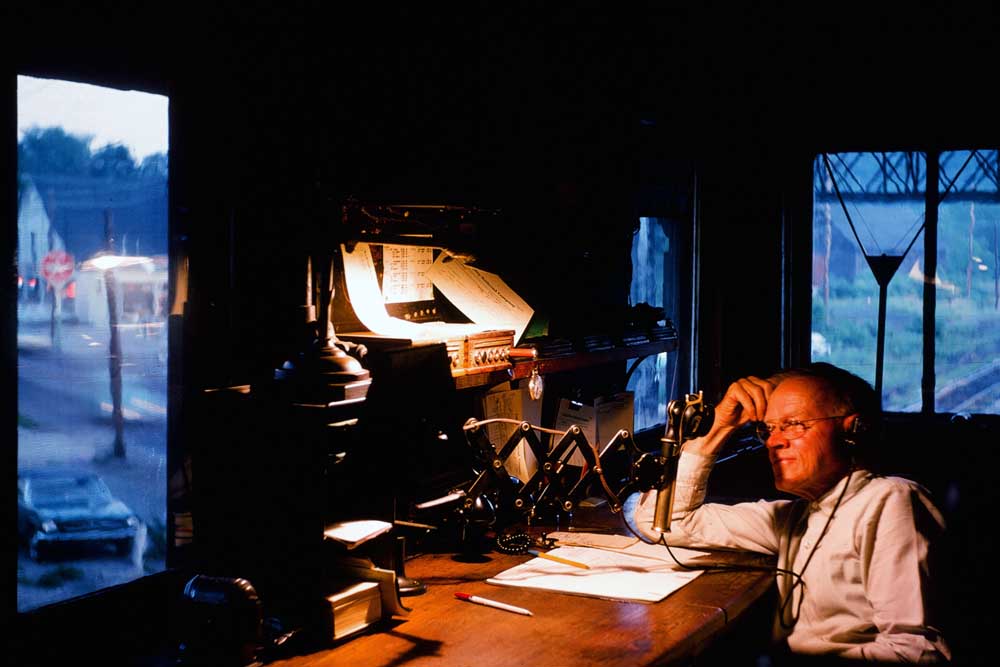
Hooping up orders
It was well after 3:30 a.m. when the yard office called to report BNE-2 was on its way down the eastbound leader. I notified the Wilkes-Barre dispatcher of BNE-2’s departure from Sayre. He instructed me to prepare a Clearance Card Form C authorizing BNE-2 to leave Athens and to indicate there were no orders for the train. After completing the Clearance Card, I attached them to the strings on the train-order hoops.
Once the hoops were ready, I unlocked, reversed, and relocked the crossover and eastbound leader switch then cleared the eastbound leader home signal. Then I lowered the gates after the locomotive’s headlight appeared, held the hoop out the window and down far enough for the engine crew to grab their card, and lowered the basket and hoop. Almost simultaneously I observed the train for defects, gave a highball signal to the rear-end crew, raised the gates after the caboose passed, restored the eastbound leader signal lever to normal, unlocked the switches, restored them to normal positions, and relocked them.
Next came retrieving the train summary and notifying the dispatcher of its departure and consist, plus notifying Towanda of the train’s leaving. Finally, I contacted the Coxton yard office by telephone via the Sayre yard office, LV trunk line, and Coxton local line and dictated the train consist details to the yard telegrapher. This information would be used by the yardmaster to prepare for switching BNE-2 upon its arrival.
Sayre yard office called to report that an eastbound extra freight was coming down the eastbound leader and the relief engine was coming east on the westbound leader. Upon notifying him of these moves, the dispatcher dictated a Form 19 train order addressed to the relief crew and myself granting the relief conductor and engineer “right over opposing trains on number one track from Athens Tower to Milan.” I repeated the order to the dispatcher and he authorized me to prepare a clearance card with the train order.
My next move as railroad tower operator was to unlock, reverse, and relock the westbound leader switch and clear the eastbound leader signal. I waited for the engine, another aging 2-8-2, lowered the gates, went downstairs, crossed the eastbound main and delivered the clearance cards and train order to the crew. The engine left about 4:30 a.m. I reported its departure to the dispatcher.
Crossing over FFW-1
About the same time, Towanda reported the passing of BNE-2. The dispatcher instructed the Towanda operator to have FFW-1 back over the crossover to the eastbound main track. Next, he called Towanda and myself and dictated a train order to FFW-1’s crew giving them authority to operate westbound on number two track from Towanda to Athens. We both repeated and completed the order and Towanda prepared a clearance card for the westbound train’s crew. The final step was for me to block the eastbound signal levers as a safety precaution in accordance with the Book of Rules.
Thirty minutes later, Towanda reported departure of FFW-1 on the eastbound main. About 5:15, the Towanda block line rang and the relief crew conductor reported they were leaving Milan with the extra west. I notified the train dispatcher and called the yard office to report on both consists.
With both westbound trains approaching, I reversed the crossover and the westbound leader switches. Once the trains occupied their approach circuits, I cleared their respective signals and lowered the crossing gates. FFW-1 would cross over from the eastbound to westbound main tracks and the extra would move from the westbound main to the westbound leader.
Both appeared about 5:30 a.m. and almost simultaneously the first-trick railroad tower operator arrived for work. He’d come early to accommodate my plan to leave Sayre on Train 11, scheduled to depart at 6:15 a.m. After briefing him on the situation, I picked up my suitcase and began a walk to Sayre station.
Safely on board the Star, I headed home to Ithaca for rest. In 17 hours, I’d be climbing the Cortland Junction, N.Y. tower steps to prepare for another vacation relief assignment as a railroad tower operator.






